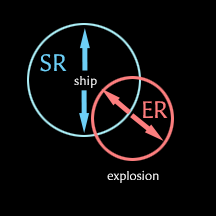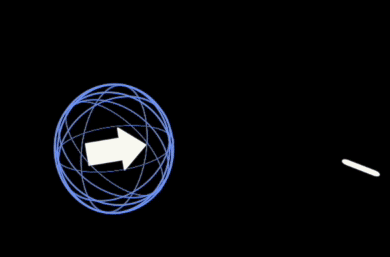Difference between revisions of "User:Qwer Stoneghost/Old user page"
| Line 37: | Line 37: | ||
== Missile Targeting, Range and Speed == | == Missile Targeting, Range and Speed == | ||
| − | A missile will leave the launcher and proceed at its best speed until it hits the limit of its range. If it encounters the target during that time, it will explode - otherwise it will vanish | + | A missile does not so much hit a ship as explode near it. When a missile crosses the signature radius of its target, it explodes. The speed at which this explosion grows and the maximum size of the explosion determine the amount of damage done to the target. |
| + | [[File:QSG_missile_terms.png|thumb|right|upright=0.8|A Missile Explodes|alt=drawing showing SR and ER]][[File:QSR_missile_hit.gif|A Missile Explodes|alt=animation of missile hitting ship]] | ||
| + | EVE uses a mathematical equation to compute the precise amount of damage that the explosion does to the ship. You can read about the details of what happens when a missile hits in the [[Missile Damage]] article. | ||
| + | |||
| + | When fired, a missile will leave the launcher and proceed at its best speed until it hits the limit of its range. If it encounters the target during that time, it will explode - otherwise it will vanish. | ||
Each missile can travel a certain distance before it runs out of fuel. If the target is stationary, then this distance will be the missile's range. Normally, however, the target is moving. | Each missile can travel a certain distance before it runs out of fuel. If the target is stationary, then this distance will be the missile's range. Normally, however, the target is moving. | ||
| − | + | [[ |Orbiting Missile Target|alt=animation of missile hitting orbiting ship]] | |
| − | [[ | ||
| − | |||
== Launcher Types == | == Launcher Types == | ||
Revision as of 14:21, 11 December 2015
the boonie wiki eat loony members of the EU any chat - don't forget to read what you dictate
Introduction: Doing Damage
The two basic types of weapon systems are Turrets and Launchers. Turrets fire a stream of damage (projectiles, charges, laser beams) that travels in a straight line out from the turret as the turret moves to track the target. Launchers fire self-propelled bundles of damage (rocket, missile, torpedo) that chase down the target. (There are exceptions, but most weapons follow one of these patterns.)
In each case, the actual damage done to the target depends on a number of factors. You can read the details in these two articles: Turret Damage / Missile Damage - but for now it is enough to recognize that the two weapons systems do damage in different ways. Given that the target is within range of the weapon, then the final damage to the target depends on:
| Launcher | Turret |
|---|---|
| Basic damage amount | Basic damage interval |
| Signature radius of target | Transversal speed |
| Velocity of target | Turret tracking |
| Explosion radius of missile | Turret signature resolution |
| Explosion velocity of missile | Target signature radius |
| Damage reduction factor | Turret optimal range |
| Turret range falloff |
The difference, in simple terms, is that launchers will always "hit", but the damage done will vary depending on the size of the target and the speed of the explosion. On the other hand, turrets may miss the target, but a hit will always do its basic (somewhat variable) amount of damage.
It may seem that a 100% chance to hit any target within range is a significant advantage, however this is balanced by other factors, including especially the firing speed of the weapon and the travel time of the damage bundle. In general, launched weapons fire more slowly and take more time to strike their targets, thus leaving their ships more open to retaliation. In any case, you can rest assured that neither type of weapons system has an advantage over the other in and of itself. The advantages arise from the ship bonuses, ship fittings, and pilot skills and experience.
The remainder of this article will deal with the mechanics and characteristics of launcher based weapons systems. Damage done will be compared in absolute terms. For a very detailed explanation of how the damage of an individual hit is created when the weapon hits its target, please refer to the article on Missile Damage.
Note that launcher based damage bundles are often called "missiles", and that this term can refer to any of rockets, missiles, torpedos and bombs (even though bombs are not fired from launchers).
Missile Targeting, Range and Speed
A missile does not so much hit a ship as explode near it. When a missile crosses the signature radius of its target, it explodes. The speed at which this explosion grows and the maximum size of the explosion determine the amount of damage done to the target.
EVE uses a mathematical equation to compute the precise amount of damage that the explosion does to the ship. You can read about the details of what happens when a missile hits in the Missile Damage article.
When fired, a missile will leave the launcher and proceed at its best speed until it hits the limit of its range. If it encounters the target during that time, it will explode - otherwise it will vanish.
Each missile can travel a certain distance before it runs out of fuel. If the target is stationary, then this distance will be the missile's range. Normally, however, the target is moving.
[[ |Orbiting Missile Target|alt=animation of missile hitting orbiting ship]]
Launcher Types
Each launcher class can launch multiple types of missiles of that class. Generally, the missile types vary the damage type, flight time, and other tactical characteristics.
For example, a xxxxx launcher can fire 3 types of missiles:
Launchers have various characteristics, including such as firing rate, ...
